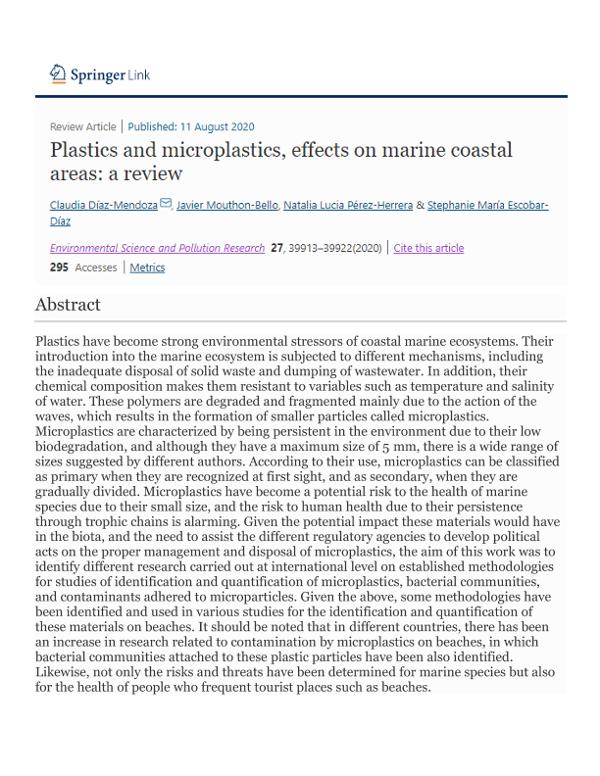Plastics and microplastics, effects on marine coastal areas: a review

View/
Date
2020-08-11Author
Díaz Mendoza, Claudia
Mouthon-Bello, Javier
Pérez-Herrera, Natalia Lucía
Escobar-Díaz, Stephanie
Metadata
Show full item recordAbstract
Plastics have become strong environmental stressors of coastal marine ecosystems. Their introduction into the marine ecosystem is subjected to different mechanisms, including the inadequate disposal of solid waste and dumping of wastewater. In addition, their chemical composition makes them resistant to variables such as temperature and salinity of water. These polymers are degraded and fragmented mainly due to the action of the waves, which results in the formation of smaller particles called microplastics. Microplastics are characterized by being persistent in the environment due to their low biodegradation, and although they have a maximum size of 5 mm, there is a wide range of sizes suggested by different authors. According to their use, microplastics can be classified as primary when they are recognized at first sight, and as secondary, when they are gradually divided. Microplastics have become a potential risk to the health of marine species due to their small size, and the risk to human health due to their persistence through trophic chains is alarming. Given the potential impact these materials would have in the biota, and the need to assist the different regulatory agencies to develop political acts on the proper management and disposal of microplastics, the aim of this work was to identify different research carried out at international level on established methodologies for studies of identification and quantification of microplastics, bacterial communities, and contaminants adhered to microparticles. Given the above, some methodologies have been identified and used in various studies for the identification and quantification of these materials on beaches. It should be noted that in different countries, there has been an increase in research related to contamination by microplastics on beaches, in which bacterial communities attached to these plastic particles have been also identified. Likewise, not only the risks and threats have been determined for marine species but also for the health of people who frequent tourist places such as beaches.
Citar como
Díaz-Mendoza, C., Mouthon-Bello, J., Pérez-Herrera, N.L. et al. Plastics and microplastics, effects on marine coastal areas: a review. Environ Sci Pollut Res 27, 39913–39922 (2020). https://doi.org/10.1007/s11356-020-10394-yRecurso Original
https://link.springer.com/article/10.1007/s11356-020-10394-y#:~:text=Plastics%20have%20become%20strong%20environmental%20stressors%20of%20coastal%20marine%20ecosystems.&text=It%20should%20be%20noted%20that,particles%20have%20been%20also%20identified.Todo el contenido:
https://link.springer.com/article/10.1007/s11356-020-10394-y#:~:text=Plastics%20have%20become%20strong%20environmental%20stressors%20of%20coastal%20marine%20ecosystems.&text=It%20should%20be%20noted%20that,particles%20have%20been%20also%20identified.Collections
- Productos de investigación [1453]
Compatible para recolección con:

Archivos
Universidad Tecnológica de Bolívar - 2017 Institución de Educación Superior sujeta a inspección y vigilancia por el Ministerio de Educación Nacional. Resolución No 961 del 26 de octubre de 1970 a través de la cual la Gobernación de Bolívar otorga la Personería Jurídica a la Universidad Tecnológica de Bolívar.











